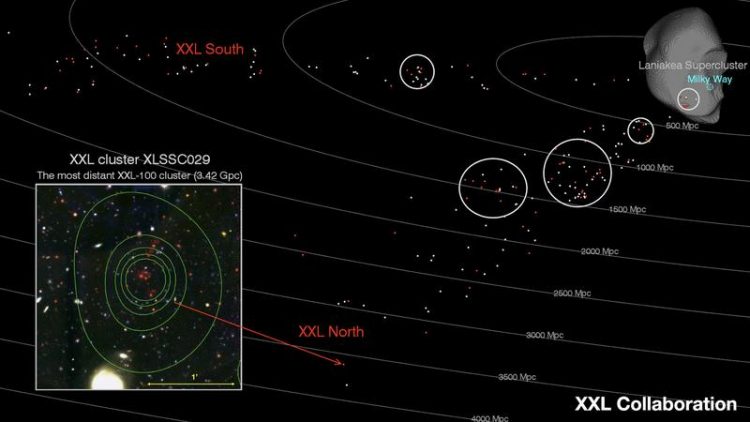In search of dark energy

The XXL Project monitors two parts of the universe (XXL North and XXL South). The white dots show the galaxy clusters detected so far, the red dots the 100 brightest clusters. (c) Project XXL - D. Pomarède (SDvision software)
Our Universe looks like a gigantic sponge: vast spaces (the holes of the sponge) are completely devoid of matter. Filaments made of galaxies and interstellar gas delineate the boundaries of the voids. These form the main structure of the sponge.
Where filaments cross, the matter density is the largest: thousands of galaxies aggregate in small volumes. These are known as clusters of galaxies. Researchers from all over the world are currently busy measuring this structure.
Indeed, it provides a wealth of information on the origin of the Universe. In particular, scientists hope to shed light on a mysterious constituent of our Universe, the dark energy. This diffuse energy component essentially works like an interstellar baking powder: it drives the cosmos to inflate ever faster.
Dark matter and dark energy
Our ability to see the stars glow in a clear night sky results from a small irregularity. During the big-bang all the cosmic material was gathered into one huge gazeous cloud – almost uniformly, but not exactly: in certain places the cloud was a little bit denser than in others.
Hence, these overdense areas exerted a stronger gravitational pull and attracted the surrounding material to them. With time, more and more matter concentrated around these seeds. In contrast, the space between them became ever emptier. This is how the sponge structure that we now witness has taken shape over the past 13 billion years.
Some 40 years ago, observations revealed that galaxies spin so fast that they should lose the stars inside them due to the centrifugal force. An invisible substance seems to prevent this from happening by its gravitational attraction – the dark matter. About 85 percent of the matter in the Universe is composed of this exotic constituent. The dark matter also accelerated the formation of the sponge structure we see today.
The dark matter makes the Universe so heavy that it should significantly slow down the expansion of the Universe. Yet, this does not happen: according to recent observations, the expansion has actually sped up. The probable cause of this phenomenon is the dark energy. It is tearing appart the Universe in spite of the powerfull gravitational attraction. What exactly dark energy is made of remains unknown.
To help answer this question, an international team of researchers are using a satellite from the European Space Agency (ESA) that is capable of detecting X-rays to map a large area of the sky to an unprecedented depth. The hot gas in clusters of galaxies radiates X-ray emission and can therefore be observed with this satellite. The scientists intend to discover about 500 of these clusters of galaxies and to study them in detail.
Some of them are as far as 10 billion light-years away – 2/3rd of the size of the observable universe. With these clusters, they intend to map out the three dimensional structure of a representative portion of the Universe. By using clusters of galaxies to accurately trace the skeleton of this structure, the team can investigate the forces that gave it shape: both the gravitational pull induced by the distribution of regular and dark matter, but also the mysterious counteracting dark energy.
’We have processed the X-ray data at the University of Bonn’, explains Dr. Florian Pacaud from the Argelander-Institut für Astronomie. ’In the present series of publications, we present a first part of our results, the analysis of the 100 brightest clusters of galaxies’. With this, the scientists could already confirm a recent result that puzzled the cosmologists in the last couple of years: there seem to be significantly less clusters than expected. In addition, the researchers directly observed the process of structure formation in action: they found clear evidence for the existence of superclusters in their observations. Superclusters consist of several clusters of galaxies bound together by their respective gravity. They are expected to collapse into a larger cluster of galaxies in the near future.
More than 100 scientists from all over the globe collaborate in this large project entitled ’XXL’. The project is lead by Dr. Marguerite Pierre from the CEA/Saclay Institute in France. More details can be found on the dedicated website: http://irfu.cea.fr/xxl.
Publication: F. Pacaud et al.: The XXL Survey: II. The bright cluster sample – catalogue and luminosity function; Astronomy and Astrophysics
Contact:
Dr. Florian Pacaud
Argelander-Institut für Astronomie
University of Bonn
Tel. 0228/736788
Email: fpacaud@uni-bonn.de
http://arxiv.org/abs/1512.04264 Publication
Media Contact
All latest news from the category: Physics and Astronomy
This area deals with the fundamental laws and building blocks of nature and how they interact, the properties and the behavior of matter, and research into space and time and their structures.
innovations-report provides in-depth reports and articles on subjects such as astrophysics, laser technologies, nuclear, quantum, particle and solid-state physics, nanotechnologies, planetary research and findings (Mars, Venus) and developments related to the Hubble Telescope.
Newest articles

Properties of new materials for microchips
… can now be measured well. Reseachers of Delft University of Technology demonstrated measuring performance properties of ultrathin silicon membranes. Making ever smaller and more powerful chips requires new ultrathin…

Floating solar’s potential
… to support sustainable development by addressing climate, water, and energy goals holistically. A new study published this week in Nature Energy raises the potential for floating solar photovoltaics (FPV)…

Skyrmions move at record speeds
… a step towards the computing of the future. An international research team led by scientists from the CNRS1 has discovered that the magnetic nanobubbles2 known as skyrmions can be…





















